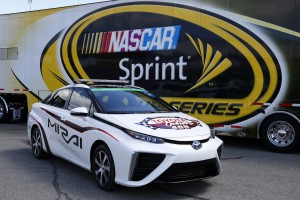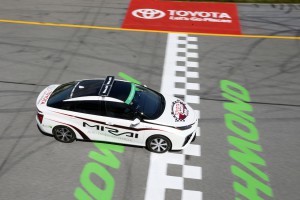
The Toyota Mirai hydrogen fuel cell vehicle is the first hydrogen-powered pace car in NASCAR history.
Part of the thrill of attending a NASCAR race is the roar of the cars as they pass by led by the pace car at the start of the race. However, the Toyota Owners 400 on Saturday night had a little different feel as the cars were led by Toyota’s Mirai hydrogen fuel cell pace car.
While it didn’t exactly sound like the car from the Jetsons as it cruised the through the banked oval turns in Richmond, Virginia, it was definitely a different sound. Despite the lack of thunder from the Mirai, the fuel-cell-powered EV did make some noise as the first car of its kind to pace a NASCAR race.
“Having a hydrogen fuel cell vehicle pace the Toyota Owners 400 is an historic moment for both Toyota and NASCAR and we’re proud it’s the Toyota Mirai,” said Ed Laukes, vice president of marketing, performance and guest experience, Toyota Motor Sales, U.S.A. “Bringing the Mirai to Richmond to pace this important race is another way for Toyota to showcase our innovation and environmental leadership.”
While being the pace car at a NASCAR race may not seem it would take much, not every car is capable. In fact, the Mirai had to go through a series of performance tests to prove it could handle the rigors associated with the task. Of course, if any company would know how to accomplish the task, it would be Toyota. In 2009, it used a Camry Hybrid to pace the Coca Cola 600. The Lexus 450h also paced a race in Australia in 2009.
Other makers have also created hybrid pace cars, including Kia with its Optima Hybrid in 2011 and the Porsche Cayenne Hybrid in 2014.
However, Ford’s been the leader when it comes to non-conventional pace cars. It developed a Fusion Hybrid to serve as the pace car for the Ford 400 at Homestead-Miami Speedway in 2008. The Dearborn, Michigan-based maker went a step further when it brought first EV pace car to the track in 2012 with the Focus EV for the Richmond 400.
While pacing a field as an EV or hybrid is great, perhaps being “the field” is even more impressive. The Formula E racing circuit is more than halfway through its first season of proving the viability and race-ability of electric vehicles.
(The ePrix searches for the right formula. For more, Click Here.)
The lack of the traditional gasoline engine roar aside, a Formula E race car is blindingly fast, launching from 0 to 60 mph in barely 2.8 seconds – only a few tenths slower than a classic Formula 1 car. And because electric motors develop wheel-spinning torque almost instantly, even veteran drivers admit shock at how quickly they launch out of corners, racing to a top speed of about 140 mph.
(Click Here for details about strong April auto sales.)
The first race ran in Beijing last Sept. 13, and is working its way through cities around the world. The Miami event will be followed next month by a Formula E race in downtown Long Beach, California. Events in Monte Carlo, Berlin and Moscow follow before the series wraps up with back-to-back races in London in June.
(To see the Queen of Green telling makers to stop crying about 54.5 mpg, Click Here.)
While the ePrix might show the upside of electric propulsion, it also highlights some of the downsides. Lithium-ion batteries make up nearly 40% of the 1950-pound weight of the one-seat, open-wheel Formula E racers. And the cars also have range issues. During the Miami race last month, the cars could only make it through half of the 39-lap race before going to the teams threw their drivers into their second vehicles and completed the race.

